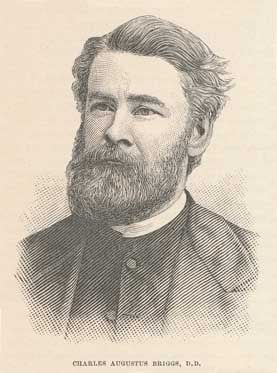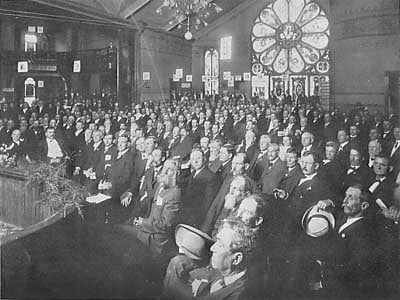A Union based on Compromise of Doctrine
 The early twentieth century in the northern Presbyterian church was increasingly one of a battle over the Bible. Charles Briggs, of Union Theological Seminary in New York City, had just been indicted for heresy and found guilty by both his presbytery and the General Assembly. In the midst of this trial and subsequent indictment, there was a proposal to revise the Westminster Standards by 15 presbyteries of the denomination. The result was the addition of two chapters to the Confession on the Holy Spirit and the Love of God and Missions, composed of chapters 34 and 35. Further, some language was changed in chapter 16 relating to the works of unregenerate men. Instead of these works being considered sinful and unable to please God, they were described as “praiseworthy.” Last, a declarative statement was added to better understand Chapter 3 of the Confession as it related to God’s eternal decree.
The early twentieth century in the northern Presbyterian church was increasingly one of a battle over the Bible. Charles Briggs, of Union Theological Seminary in New York City, had just been indicted for heresy and found guilty by both his presbytery and the General Assembly. In the midst of this trial and subsequent indictment, there was a proposal to revise the Westminster Standards by 15 presbyteries of the denomination. The result was the addition of two chapters to the Confession on the Holy Spirit and the Love of God and Missions, composed of chapters 34 and 35. Further, some language was changed in chapter 16 relating to the works of unregenerate men. Instead of these works being considered sinful and unable to please God, they were described as “praiseworthy.” Last, a declarative statement was added to better understand Chapter 3 of the Confession as it related to God’s eternal decree.
» Dr. Charles Augustus Briggs, pictured at about age 43. »
Let there be no doubt with respect to these changes. That result was that the Standards of the Westminster Assembly were watered down as to their solid Calvinism originally taught in them. Particular redemption was replaced by general redemption. Total depravity was replaced by a partial depravity. Arminianism was introduced into the subordinate standards of the church. J. Gresham Machen called the changes to be “highly objectionable,” “a calamity,” and “a very serious lowering of the flag.”
Whether such a momentous change was due to potential union talk or not, it is interesting that soon after this change, joint discussions arose with the possibility of union with the Cumberland Presbyterian Church and the Northern assembly of the Presbyterian church. Remember, around 1810, a division occurred over Calvinism and the Westminster Standards in the Presbyterian Church, which division brought about the Cumberland Presbyterian Church. Now this Arminianism denomination was being invited to reunite with the Northern Presbyterian Church, without any change on their part with regards to their Arminian beliefs. The plans for that union were adopted on February 19, 1904. After some further refinements to the plans, the last General Assembly of the old Cumberland Presbyterian Church met in May of 1906 [pictured below].
 Over 1100 Cumberland Presbyterian teaching elders joined the ranks of the Presbyterian Church, bringing their number up to 9,031 men. Over 90,000 members came into the fold of the Presbyterian church. The union wasn’t complete however, in that, some 50,000 stayed out of the union, and continued on as the Cumberland Presbyterian Church. But what was found in the union meant in reality that the Presbyterian church was no longer uncompromisedly Reformed in doctrine and life. That was to have a profound effect on the next 30 years of existence and testimony.
Over 1100 Cumberland Presbyterian teaching elders joined the ranks of the Presbyterian Church, bringing their number up to 9,031 men. Over 90,000 members came into the fold of the Presbyterian church. The union wasn’t complete however, in that, some 50,000 stayed out of the union, and continued on as the Cumberland Presbyterian Church. But what was found in the union meant in reality that the Presbyterian church was no longer uncompromisedly Reformed in doctrine and life. That was to have a profound effect on the next 30 years of existence and testimony.
Words to Live By: Beware of a tendency to lower your Biblical testimony, and that of your church or denomination, to suit the ever-changing sentiments of the world around you. Your standard is always the Word of God, never the word of man.
Tags: Cumberland Presbyterian Church, General Assembly, Northern Presbyterian Church, Westminster Standards

No comments
Comments feed for this article